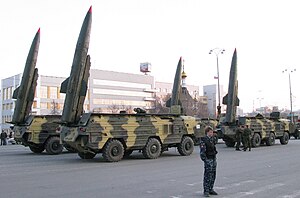| OTR-21 Tochka SS-21 Scarab | |
|---|---|
 | |
| Type | Tactical ballistic missile |
| Place of origin |
|
| Service history | |
| In service |
1976 – present (Scarab A) 1986 – present (Scarab B) |
| Used by | See operators |
| Production history | |
| Manufacturer | KBM (Kolomna) |
| Specifications | |
| Mass |
2,000 kg (4,400 lb) Scarab A 2,010 kg (4,430 lb) Scarab B |
| Length | 6.4 m (21 ft) |
| Diameter | 0.65 m (2 ft 2 in) |
| Warhead | Chemical, 100 kt nuclear warhead, EMP, or fragmentation filling |
|
| |
| Engine | Single-stage solid propellant |
Operational range |
70 km (43 mi) Scarab A 120 km (75 mi) Scarab B |
| Maximum speed | 1.8 km/s (1.1 mi/s) |
Guidance system | Inertial with GLONASS |
Launch platform | BAZ-5921 Mobile TEL |
OTR-21 Tochka (Russian: оперативно-тактический ракетный комплекс (ОТР) «Точка»; English: Tactical Operational Missile Complex "Tochka", "Point") is a Soviet short-range tactical ballistic missile. Its GRAU designation is 9K79; its NATO reporting name is SS-21 Scarab. It is transported in a 9P129 vehicle and raised prior to launch. It uses an inertial guidance system. The OTR-21 forward deployment to the German Democratic Republic began in 1981, replacing the earlier FROG series of unguided ballistic missiles.
Description[]
The OTR-21 is a mobile missile launch system, designed to be deployed along with other land combat units on the battlefield. While the FROG-7 is large and relatively inaccurate, the OTR-21 is much smaller. The missile itself can be used for precise strikes on enemy tactical targets, such as control posts, bridges, storage facilities, troop concentrations and airfields. The fragmentation warhead can be replaced with a nuclear, biological or chemical warhead. The solid propellant makes the missile easy to maintain and deploy. OTR-21 units are usually managed in a brigade structure. There are 18 launchers in a brigade; each launcher is provided with 2 or 3 missiles. The vehicle is completely amphibious, with a maximum road speed of 60 km/h (37 mph) and 8 km/h (5.0 mph) in water. It is NBC-protected. The system has been in development since 1968. Three variants have been created.
Scarab A[]
The initial Scarab A entered service with the Soviet Army in 1975. It carries one of three types of warhead:
- 482 kg (1,063 lb) of conventional HE
- fragmentation (lethal radius more than 200 m (660 ft)
- nuclear
The minimal range is about 15 km (9.3 mi), maximum range is 70 km (43 mi); its Circular Error Probable (CEP) is estimated to be about 150 m (490 ft).
Scarab B[]
The improved Scarab B (Tochka-U) was introduced in 1989. Improved propellant increased the range to 120 km (75 mi). CEP significantly improved, to less than 95 m (312 ft).
Scarab C[]
A third variant, Scarab C, was developed in the 1990s. Again, range increased (185 km (115 mi)), and CEP decreased[citation needed]. Scarab C weighs 1,800 kg (4,000 lb).
Others[]
North Korea has developed a local variant, the KN-02 Toksa (Viper), by reverse-engineering Syrian-supplied Scarab A missiles.[1] The Toksa has a range of 120-140 kilometers, and it is the most accurate ballistic missile in KPA's inventory to date. The KN-02 uses a MAZ-630308-224 truck instead of the 9P129.
Use in combat[]
Russia used the missiles in the Chechen Wars.[2]
At least 15 Tochka missiles were deployed by Russian forces from August 8–11 during the 2008 South Ossetia war.[3]
In April 2013 about 14 Tochka missiles were fired into the contested district of Barzeh on the northeastern edge of Damascus.[4]
Operators[]
 Armenia
Armenia- At least 8 launchers Tochka-U
 Azerbaijan
Azerbaijan- 3 launchers Tochka-U with 4 missiles
 Belarus
Belarus- 36 [5]
 Bulgaria
Bulgaria- 8 launchers and 21 missiles (Scarab-A)
 Kazakhstan
Kazakhstan- unknown number
Russia
- 96 launchers.[6] Missile systems have been upgraded since 2004 (replacing the onboard automated control systems), in 2011 there were 40 launchers unfit for combat, in 2012 the number of unfit for combat could rise to 80, after the modernization of the Tochka was refused.[7][8]
 Ukraine
Ukraine- 90 [9]
 Syria
Syria- 1 brigade plus at least 36 missiles
 Yemen
Yemen- 10
 North Korea
North Korea- unknown number of variant KN-02
Former operators[]
 Czechoslovakia
Czechoslovakia- passed on to successor states.
 Czech Republic
Czech Republic- inherited from Czechoslovakia, retired.
 East Germany
East Germany- retired
 Hungary
Hungary- less than 10, retired
 Poland
Poland- 4 [10] retired in 2005, because of lack of rockets and service parts
 Slovakia
Slovakia- small number, inherited from Czechoslovakia, all retired.
Soviet Union
- Passed on to successor states.
References[]
- ↑ globalsecurity.org
- ↑ "It Was No Spontaneous, But Planned War". http://en.novayagazeta.ru/data/2008/59/01.html.
- ↑ Fulghum, David A.; Douglas Barrie, Robert Wall and Andy Nativi (2008-08-15). "Georgian Military Folds Under Russian Attack". http://www.aviationweek.com/aw/generic/story_generic.jsp?channel=awst&id=news/aw081808p2.xml&headline=Georgian%20Military%20Folds%20Under%20Russian%20Attack. Retrieved 2008-11-09.
- ↑ "Activists: Rocket attack in Syrian capital kills 5". http://www.haaretz.com/news/middle-east/activists-rocket-attack-in-syrian-capital-kills-5.premium-1.513725.
- ↑ Belarus Army Equipment
- ↑ http://warfare.be/db/catid/363/linkid/1704/title/ss-21-scarab-/-otr-21-tochka-u/
- ↑ http://www.militaryparitet.com/ttp/data/ic_ttp/173/
- ↑ The Military Balance 2010. — P. 223.
- ↑ Ground Forces Equipment - Ukraine
- ↑ MILITARIUM - Wojsko Polskie - Uzbrojenie
External links[]
| Wikimedia Commons has media related to OTR-21 Tochka. |
- SS-21 Scarab article on Warfare.ru
- Tochka-U Video
- SS-21 Scarab (9K79 Tochka)
- (Russian) OTR Tochka
- MissileThreat.com SS-21
- Jane's Defence news on North Korean SS-21 test, April 2006
| ||||||||||||||||||||||||||||||||||||||||||||||||||||||||||||
The original article can be found at OTR-21 Tochka and the edit history here.